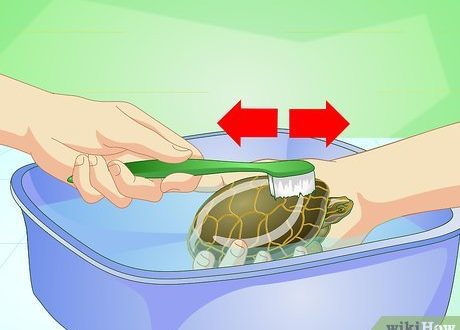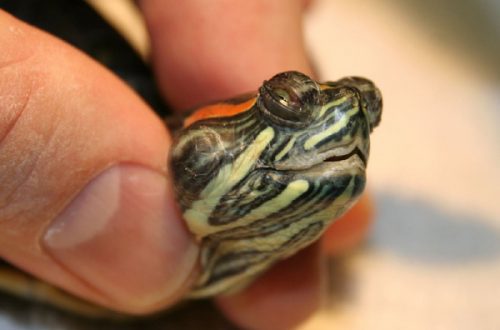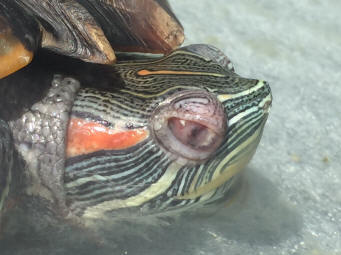
The red-eared turtle has swollen eyes and does not open, she is blind and does not eat: what to do, how to treat at home?
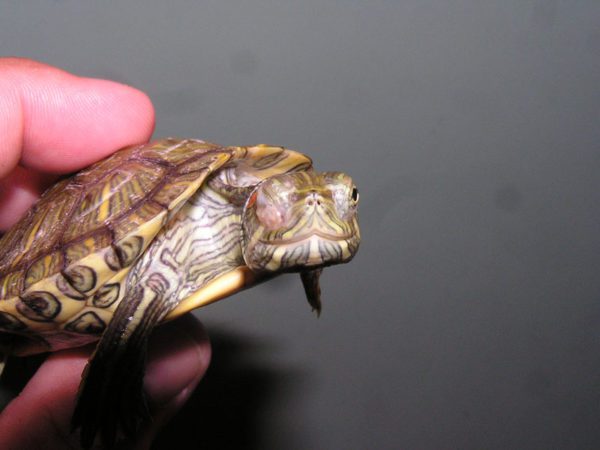
An indicator of the health of an aquatic turtle is the condition of its eyes. In a healthy pet, the organs of vision are clear, clean and open with good mobility of the eyeball. If the reptile has closed its eyes and does not open them, this is a reason to contact herpetologists. In the absence of timely treatment, the animal may go blind or die.
Contents
How to understand that the turtle’s eyes hurt
It will not be difficult for an attentive owner to notice changes in the organs of vision in time, inexperienced or busy owners may miss the onset of the disease, which is fraught with a deterioration in the animal’s condition or difficulty in diagnosis and treatment.
Signs of ophthalmic diseases of turtles are the following symptoms:
- the turtle has watery, swollen, constantly closed eyes, sometimes with a white or yellow dried film;
- the reptile does not open one eye;
- there is a pronounced swelling of the eyelids and eyes, the organs of vision swell and stick together;
- under the eyelids, a burgundy inflamed mucous membrane of the eye is found;
- turbidity occurs on the cornea or whitish-blue films appear;
- sometimes there may be lacrimation, clear mucous or white purulent discharge from the eyes;
- the pupil does not react to light or photophobia develops;
- the pet is poorly oriented in space;
- there is difficulty in moving the eyeball.
If a red-eared turtle has swollen eyes and does not open, this can be a symptom of not only ophthalmic diseases.
External changes in the eyes are sometimes accompanied by a similar clinical picture:
- the animal does not open its eyes and does not eat;
- there is a general weakness, lethargy and inhibition of movements;
- the red-eared turtle swims with its eyes closed, sometimes falls on its side;
- cannot dive;
- when swimming, you may notice the release of blisters or a foamy mass from the nose or mouth;
- there is a violation of coordination of movements, paralysis, convulsions, failure of the hind limbs;
- the pet breathes heavily, coughs, often opens its mouth, makes clicks and wheezing;
- the skin flakes, swells, white or red nodules, spots, cotton-like plaque or ulcers appear on the shell and skin;
- the turtle often rubs its muzzle with its paws, nasal mucous or purulent discharge is observed;
- the shell softens, fails or arches, horny shields overlap each other, bend upwards;
- there are multiple bleeding, prolapse of the cloaca, fractures of the limbs.
Complications due to eye diseases or the lack of timely therapeutic can cause partial or complete loss of vision of the reptile, as well as the premature death of a little friend. Therefore, if the red-eared turtle does not open its eyes and does not eat, it is recommended to find a competent specialist and start treatment within 2 days from the onset of the disease.
Why doesn’t he open his eyes?
A huge number of reasons can lead to swollen eyes in a reptile, before contacting a herpetologist, it is necessary to remember the changes in the care, maintenance and behavior of a pet a few days before the disease. This is essential for correct diagnosis and appropriate treatment. Most often, the red-eared turtle cannot open its eyes with the following pathologies.
Ophthalmic diseases
These include:
- conjunctivitis;
- panophthalmitis;
- blepharoconjunctivitis;
- uveitis;
- keratitis;
- optic neuropathy.
The causative agents of inflammatory eye diseases in turtles are pathogenic microflora that develops in dirty water.
Often the causes of ophthalmic pathologies in reptiles are:
- microtraumas;
- burns;
- lack of vitamin A;
- diseases of the facial vessels and nerves.
In a sick animal:
With injuries, you can find blood on the eyes and eyelids, most often the turtle is lethargic and does not eat.
Respiratory and cold diseases
These include rhinitis and pneumonia, which occur when the animal’s body is overcooled.
The cause of inflammation of the respiratory organs is:
- low temperature of water and air in the room;
- lack of a fluorescent lamp;
- drafts;
- finding a reptile on a cold floor.
For pneumonia in turtles:
- closed eyes;
- there is a list when swimming;

- diving difficulties;
- the pet is breathing heavily;
- coughing and wheezing;
- exudes foam from the mouth.
Runny nose in reptiles is characterized by:
- constant itching of the nose and organs of vision;
- the animal cannot open its eyes;
- the pet’s mouth is constantly open;
- mucus or foam is released from the mouth and nose;

- reptile often squeaks.
If the turtle becomes ill due to hypothermia, it does not eat, becomes lethargic and slow.
Infectious pathologies
These include:
- bacterial;
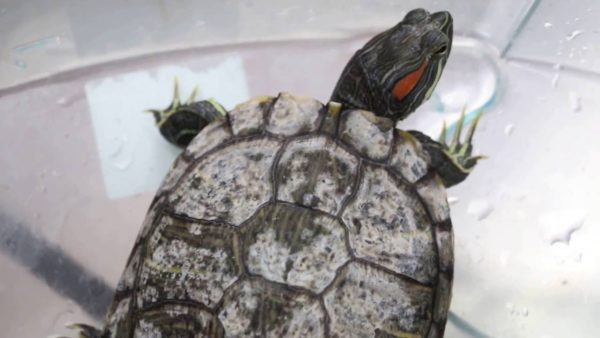
- parasitic;
- fungal diseases.
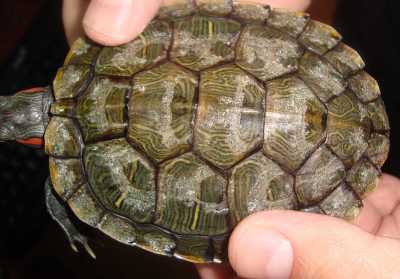
An animal can catch a contagious disease through contact with or keeping with a sick reptile, infectious agents can be found in dirty water, pet food and soil. Concomitant factors for the development of infectious pathologies are improper feeding and maintenance of red-eared turtles.
Lack of vital vitamins leading to hypovitaminosis A and rickets
Both pathologies cause degenerative changes in the body of turtles and can be fatal.
Insufficient intake of vitamin A is manifested by:
- violation of the normal position of the body of a reptile in the water;
- swelling of the eyes;

- the appearance of a “white web” on the shell and skin;
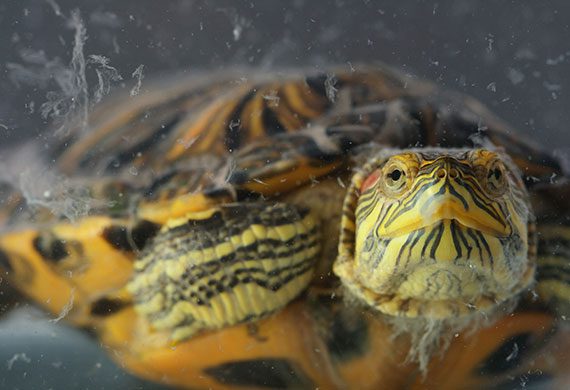
- the formation of ulcers on the mucous membranes.
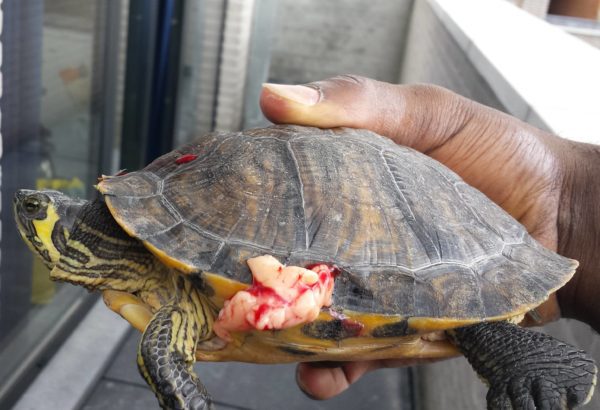
Lack of vitamin D leads to impaired absorption of calcium and the development of rickets.
With pathology:
Hypoavitaminosis A and rickets develop when turtles are fed predominantly plant foods without the introduction of vitamin premixes and in the absence of a source of ultraviolet radiation for reptiles.
If the red-eared turtle has swollen eyes, you should not try to determine the cause of the disease on your own and treat the animal at home with drops and ointments from a human first-aid kit. Illiterate therapy can lead to serious complications, therefore, in order for the turtle not to go blind, it is recommended to contact an experienced herpetologist or veterinarian who has experience in treating reptile diseases.
What to do if the eyes are swollen and do not open?
To cure at home an exotic pet whose eyelids are swollen and one or both eyes do not open is quite problematic, local therapy with medications or folk remedies will have an effect in uncomplicated cases of ophthalmic diseases. If the cause of swollen eyes is an infection or systemic pathology, the illiterate use of drugs will only aggravate the situation.
In a veterinary clinic, in order to clarify the etiology and make a diagnosis, the specialist collects an anamnesis and conducts a clinical examination of the four-legged patient. To find out the cause of the disease and study the physiological state of the red-eared turtle, laboratory methods for examining analyzes, radiography and puncture with further cytological examination of the biomaterial are used. Based on the data of all studies, a diagnosis is made and complex treatment is prescribed.
Therapeutic measures for diseases in turtles that occur with eye damage include the elimination of the cause of the pathology and symptomatic treatment. To increase the body’s resistance and speedy remission in all diseases accompanied by ophthalmic symptoms, vitamin and immunomodulatory drugs are prescribed. Baths in warm decoctions of herbs or anti-inflammatory solutions have a good effect.
To eliminate the cause of the disease for each pathology, certain drugs are used. Ophthalmic diseases are treated mainly with local remedies, with beriberi, therapy is aimed at replenishing the missing vitamins in the animal’s body.
Treatment of diseases of an infectious nature and respiratory diseases is carried out using specific antiviral, antibacterial, antiparasitic or antifungal agents. The choice of the drug, the method of administration of the drug and its dosage in each case is prescribed by a veterinarian, a small overdose of some drugs is deadly for reptiles.
Local therapy for eye diseases in red-eared turtles consists of the following step-by-step actions:
- The eyelids of a pet are wiped with a damp swab dipped in boiled water or chamomile decoction.
- In the presence of dried secretions, white films, cheesy exudate or gore, they are carefully removed with a cotton swab moistened with Ringer-Locke solution.

- Local anti-inflammatory eye therapy consists in the use of drops or eye ointments. In order to open the eyes of the red-eared turtle when using the ointment, it is necessary to gently pull the lower eyelid, remove dirt and lay the required amount of the drug. Liquid medicines can be dripped directly onto the closed eye, pulling back the lower eyelid of the animal after instillation so that the drop falls into the pocket formed. During the treatment procedure, the reptile tries to pull its head into the shell, so it is desirable that the neck area be fixed by an assistant.
 If the pet has only one eye closed, it is necessary to treat both organs of vision. To relieve inflammation from the eyes of turtles, the following drugs are prescribed 2 times a day: albucid, tsiprovet, tsiprovet, tobradex, tsipromed, sofradex, tetracycline ointment. The course of treatment lasts 7-10 days. In the presence of severe itching in the eye area, the turtles are prescribed a hormonal ointment – hydrocortisone, in addition to anti-inflammatory drugs, the duration of the drug is determined by the veterinarian.
If the pet has only one eye closed, it is necessary to treat both organs of vision. To relieve inflammation from the eyes of turtles, the following drugs are prescribed 2 times a day: albucid, tsiprovet, tsiprovet, tobradex, tsipromed, sofradex, tetracycline ointment. The course of treatment lasts 7-10 days. In the presence of severe itching in the eye area, the turtles are prescribed a hormonal ointment – hydrocortisone, in addition to anti-inflammatory drugs, the duration of the drug is determined by the veterinarian. - It is not recommended to bathe the turtle in anti-inflammatory baths or let it into the pool within 20 minutes after treating the eyes.
A veterinary specialist should monitor the effectiveness of the prescribed drugs and the course of recovery. In the absence of positive dynamics, it is necessary to change drugs or add new therapeutic measures.
How to care for and feed a reptile with eye diseases?
The maximum effect from the use of veterinary drugs and medical procedures is achieved when the conditions of feeding and keeping are normalized. Until complete recovery, the red-eared turtle is recommended to be kept in a dry box, the bottom of which is lined with a soft cloth. The water from the aquarium is completely drained, the glass is thoroughly washed and disinfected.
A prerequisite for the speedy recovery of the pet should be the installation of a source of ultraviolet radiation “Repti Glo” 5.0 or 8.0, installed at a distance of 25-30 cm, and a fluorescent lamp.
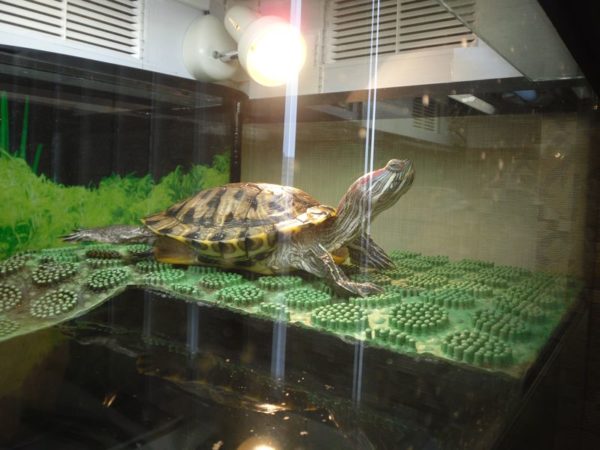
Warming up with ultraviolet light should be at least 10-12 hours a day, with a fluorescent lamp – about 7 hours. The optimum air temperature in the terrarium directly under the lamp is 30-31C, away from the light source – 28-29C.
In the summer, if the weather is warm and there is no wind, you can take the reptile outside to warm up in the sun.
The red-eared turtle should be able to swim at any time. To do this, be sure to install in the terrarium a small bath with warm water, the level of which covers only 2/3 of the body surface. In the same container, you can carry out therapeutic baths for your pet.
A special diet for ophthalmic diseases of reptiles is not prescribed, it is necessary to normalize the diet and introduce into it the products necessary for feeding the predator. Although, the red-eared turtle is more likely to be an omnivore in terms of nutrition and willingly consumes both animal and vegetable products. The diet of an aquatic reptile should include the following foods:
- live small fish;
- defrosted sea fish;
- shrimp;
- squids;
- large bloodworm;
- liver;
- carrot;
- sea kale;
- fresh greens;
- dandelion leaves;
- young cabbage.
A turtle with two closed eyes is poorly oriented in space and cannot always find food on its own in an aquarium; in such a situation, the owner must independently feed the animal from his hands or a pipette until recovery.
Prevention of eye diseases
Ophthalmic diseases in reptiles with severe course or lack of timely treatment can cause partial or complete loss of vision. In order for the red-eared turtle not to go blind, it is recommended to follow simple preventive measures:
- carefully observe the behavior of an exotic pet in water and on land;
- regularly examine the eyes, nose, shell and skin of the animal;
- install a water purification system, a thermometer, an ultraviolet and fluorescent lamp and an island in a spacious aquarium;
- periodically change the water, wash and disinfect the walls of the aquarium;
- feed the animal with various animal and vegetable foods;
- apply vitamin and mineral supplements to reptiles;
- at the first symptoms of pathology, contact a specialist.
With proper feeding and care, the eyes of an aquatic turtle will serve their mistress until old age.
Why the red-eared turtle does not open its eyes and does not eat, the eyes are swollen
3.1 (61.9%) 21 votes



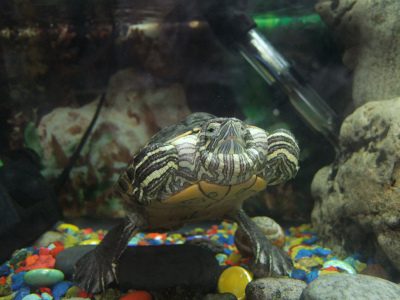
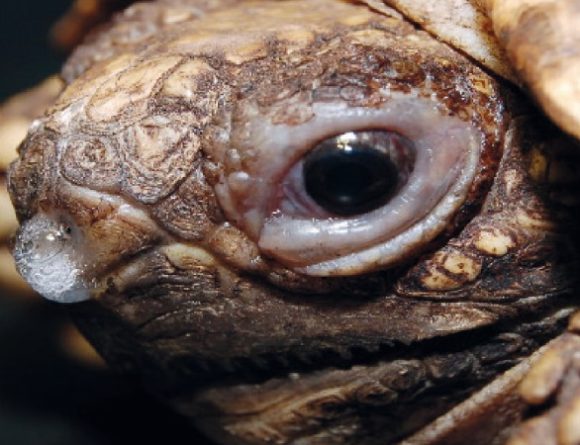
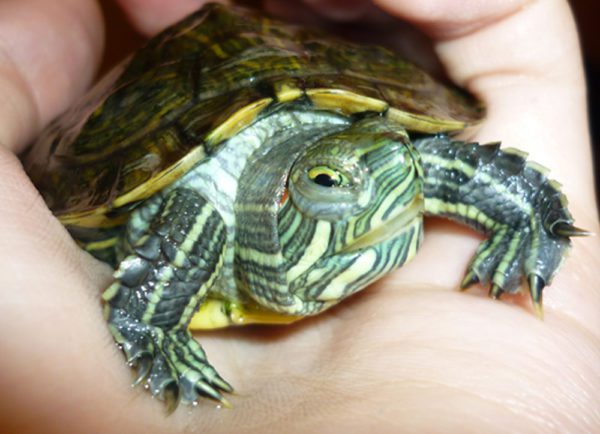
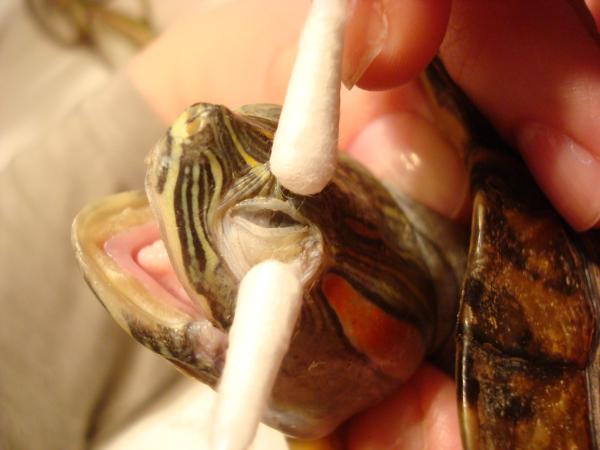
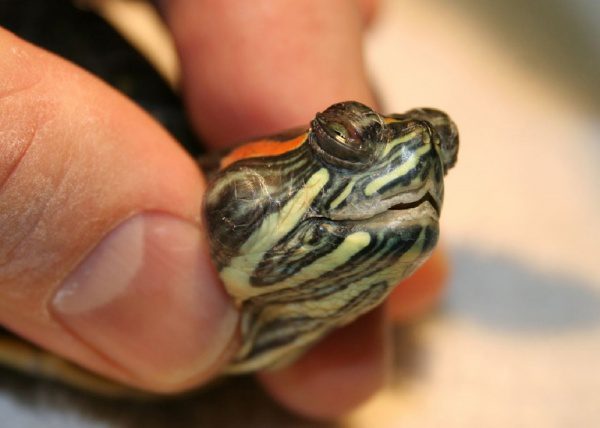 If the pet has only one eye closed, it is necessary to treat both organs of vision. To relieve inflammation from the eyes of turtles, the following drugs are prescribed 2 times a day: albucid, tsiprovet, tsiprovet, tobradex, tsipromed, sofradex, tetracycline ointment. The course of treatment lasts 7-10 days. In the presence of severe itching in the eye area, the turtles are prescribed a hormonal ointment – hydrocortisone, in addition to anti-inflammatory drugs, the duration of the drug is determined by the veterinarian.
If the pet has only one eye closed, it is necessary to treat both organs of vision. To relieve inflammation from the eyes of turtles, the following drugs are prescribed 2 times a day: albucid, tsiprovet, tsiprovet, tobradex, tsipromed, sofradex, tetracycline ointment. The course of treatment lasts 7-10 days. In the presence of severe itching in the eye area, the turtles are prescribed a hormonal ointment – hydrocortisone, in addition to anti-inflammatory drugs, the duration of the drug is determined by the veterinarian.